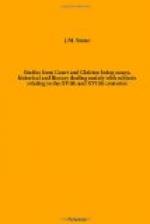But for all Anne’s prudence, and the bold front the brave woman presented to her misfortunes, she had been secretly hoping that when the inevitable crash came, she would be restored to the rights which she had only renounced, because she had no alternative. Henry, however, made no sign, and in 1543 Katharine Parr appeared on the scene. The first mention of the king’s sixth wife in the public records is a tailor’s bill for numerous items of cotton, linen, buckram, etc., and the making of Italian gowns, pleats, and sleeves, kirtles, French, Dutch, and Venetian gowns, Venetian sleeves, French hoods, etc., of various materials, the total amount of the bill being 8 pounds, 9s. 5d. This bill was delivered “to my Lady Latymer,” and was copied into the book of Skutt the tailor.
Katharine Parr had been first married as a mere child to the old Lord Borough of Gainsborough, and had been left a widow before she was seventeen. She then married Lord Latimer, who died in 1543, and was immediately sought in marriage by Sir Thomas Seymour, brother of the king’s third wife, who became Lord High Admiral in Edward’s reign. Katharine undoubtedly intended to become his wife, but as she afterwards wrote, her “will was over-ruled by a higher power.”
On the 20th June of the same year, Lady Latimer and her sister Mrs. Herbert were at court “with my Lady Mary’s Grace and my Lady Elizabeth,” and the next mention of her is in a licence of Thomas, Archbishop of Canterbury, “authorised thereto by parliament to Henry VIII. (who has deigned to marry the Lady Katharine, late wife of Lord Latimer deceased) to have the marriage solemnised in any church, chapel, or oratory, without the issue of banns.” It took place on the 12th July following, in an upper oratory called the Queen’s Privy Closet, within the honour of Hampton Court, Gardiner, Bishop of Winchester, officiating.
“Anne of Cleves [wrote Chapuys to Charles V.], would like to be in her sherte [shroud] so to speak, with her mother, having especially taken great grief and despair at the king’s espousal of this last wife, who is not nearly so beautiful as she, besides that there is no hope of issue, seeing that she had none with her two former husbands.”
Others, besides the poor, discarded Lady Anne were also in tribulation, and a letter from one of the Lutherans in England to Henry Bullinger, the reformer, reports that “the king has within these two months burnt three godly men in one day. For in July he married the widow of a nobleman named Latimer, and he is always wont to celebrate his nuptials by some wickedness of this kind.”
But Katharine herself was glad exceedingly, and told Lord Parr that “it having pleased God to incline the king to take her as his wife, which is the greatest joy and comfort that could happen to her, she informs her brother of it as the person who has most cause to rejoice thereat, and requires him to let her sometimes hear of his health, as friendly as if she had not been called to this honour.”




